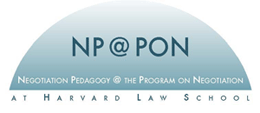
Nearly two hundred educators and trainers from eighteen countries gathered on May 15th and 16th to share ideas about teaching mediation. It was unusual for mediation teachers and trainers from fields as diverse as law, family services, public management, business, international relations, urban planning, community development, psychotherapy, and education to share ideas on how and why they teach mediation the way they do. The emphasis was very much on “show me” and not just “tell me.” So, the group watched an extended excerpt from a video of a live landlord-tenant mediation (recorded just for the Conference, but soon to be available through the PON Clearinghouse) and listened as mediation instructors from different fields identified the teaching moments in the DVD that they felt provided important learning opportunities (and why). Similarly, a group of graduate students participated in a live role play in front of the entire assembly while instructors from different fields modeled their teaching strategies by asking these students specific questions (and explained why these seemed like the right questions to ask). A third panel looked at reflective journal entries prepared by students in a mediation course and talked about how these responses indicate what our students are learning and how effectively we are teaching.
A panel on adult learning (with Professors Eleanor Duckworth and Martha Stone Wiske from Harvard’s Graduate School of Education) and a session on educational technology (led by Steven Brams, Professor of Political Science at New York University, who demonstrated his Fair Outcomes software) branched into topics of great interest to mediation teachers and trainers. The full conference explored arguments for and against “mainstreaming” mediation pedagogy — that is, teaching mediation competencies and sensibilities to a variety of learners from a wide range of disciplines and fields.
The conference was organized by MIT Professor Larry Susskind, Vice-Chair for Instruction at PON, Mike Wheeler, Professor at Harvard Business School and Melissa Manwaring, Director of Curriculum Development at PON.
In one of the three highly entertaining conference summaries, Bruce Patton from Vantage Partners and the Harvard Negotiation Project differentiated among the educational objectives of mediation teachers and trainers. Some strive to ensure that their students understand what mediation is and how it works. These instructors typically use readings, videos, and lectures to convey concepts and frameworks. They rely on papers, tests and class dialogue to determine whether students have learned what they have been taught. A second group aims to help their students develop what Bruce called “educate eyes.” These teachers arrange for their students to watch and give feedback to other mediators. They teach their students to critique mediation performance and know how to coach others. A third group of instructors (particularly trainers) want students to be able to apply what they have learned about mediation. These students need opportunities to experiment and reflect on their own performance. A final group seeks to empower their students to extend what they have learned so that they can contribute to the continued development of theory and practice. This group of learners needs to participate in rigorous comparative analyses so that they will have a basis for generating new ideas and practice moves on their own.
The full conference program is available at http://pon.harvard.edu/daily/mediation-pedagogy-conference/
For more information and to participate in the on-going dialogue contact mediationpedagogy@pon.harvard.edu.




